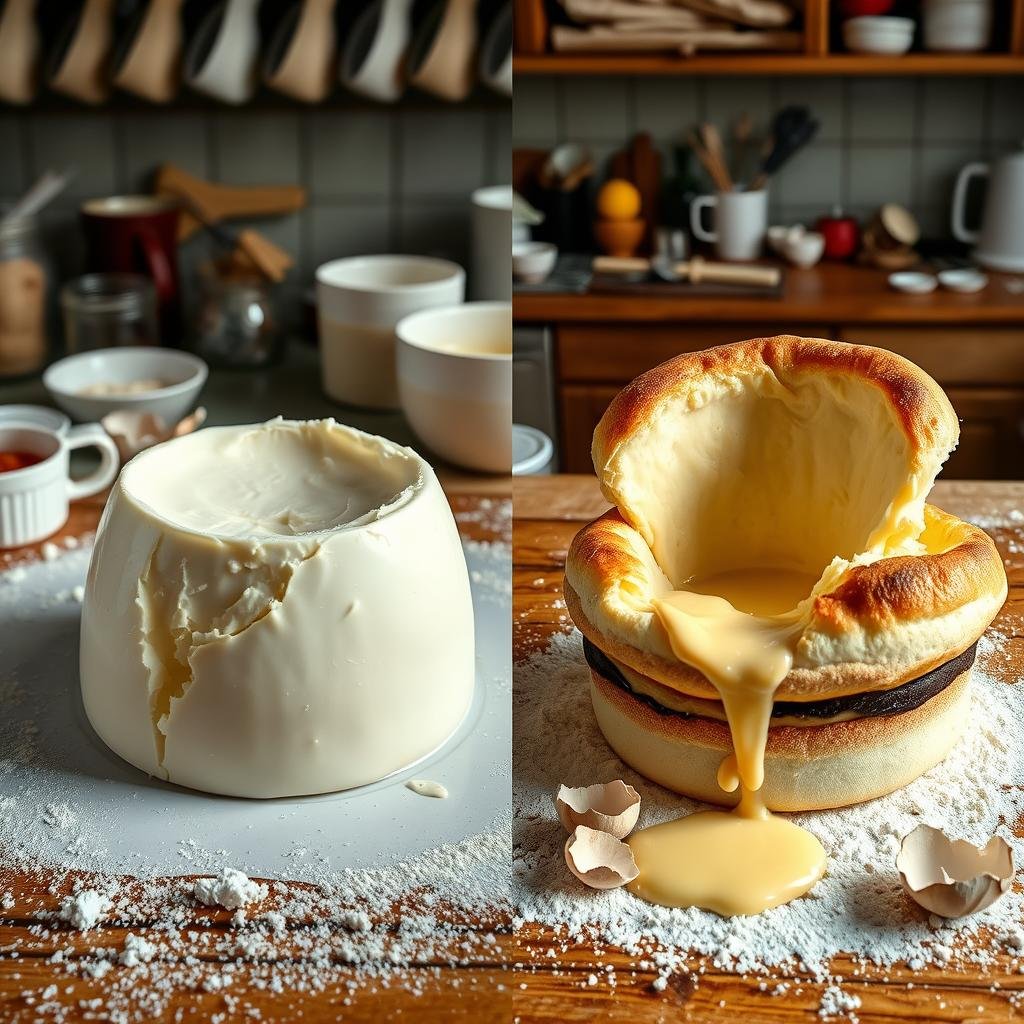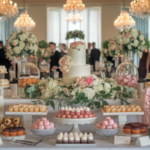I’m excited to introduce you to Panna Cotta, a classic Italian dessert known for its delicate flavor and velvety texture. This cream dessert is made from sweetened cream that’s set with gelatin, giving it a luxurious feel. As a fan of Italian desserts, I can tell you that Panna Cotta is a timeless treat that’s perfect for any occasion.
Panna Cotta is a must-try for anyone who loves cream desserts with a velvety texture. With its rich history and cultural significance, it’s no wonder why Panna Cotta remains a popular Italian dessert to this day. In this article, I’ll share my knowledge of Panna Cotta, from its origins to its preparation and variations.
Key Takeaways
- Panna Cotta is a classic Italian dessert made from sweetened cream and gelatin.
- It’s known for its delicate flavor and velvety texture, making it a luxurious treat.
- Panna Cotta is a popular cream dessert that’s perfect for any occasion.
- Its rich history and cultural significance make it a timeless Italian dessert.
- Panna Cotta can be prepared in various ways, with different flavors and toppings.
- It’s a must-try for anyone who loves Italian desserts with a velvety texture.
The Rich History of Panna Cotta
As I delve into the world of Italian cuisine, I find myself fascinated by the dessert history of Panna Cotta, a sweet treat that originated in Northern Italy. The name “Panna Cotta” translates to “cooked cream,” which gives us a glimpse into its rich and creamy texture. With its roots in Northern Italy, Panna Cotta has become a beloved dessert around the world, and its evolution is a testament to the region’s culinary expertise.
In Northern Italy, Panna Cotta has been a staple in Italian cuisine for centuries, with its creamy texture and sweet flavor making it a favorite among locals and visitors alike. As I explore the dessert history of Panna Cotta, I discover that its evolution is closely tied to the cultural significance of Italian cuisine, which emphasizes simplicity, freshness, and quality of ingredients.
Origins in Northern Italy
Panna Cotta’s origins in Northern Italy are a testament to the region’s rich culinary heritage. The dessert is often served at special occasions and is a staple in many Italian restaurants. Its popularity has spread beyond Northern Italy, and it can now be found in restaurants and cafes around the world, often with unique twists and flavor variations.
Evolution of the Recipe
Over time, the recipe for Panna Cotta has evolved, with various regions in Italy adding their own twist to the classic dessert. From the addition of fruit preserves to the use of different types of cream, the evolution of Panna Cotta is a reflection of Italian cuisine’s emphasis on creativity and experimentation.
Cultural Significance
Panna Cotta’s cultural significance in Italian cuisine cannot be overstated. It is a dessert that brings people together, and its rich history and evolution are a testament to the power of food to unite and inspire. As I continue to explore the world of Italian cuisine, I am reminded of the importance of preserving traditional recipes and techniques, while also embracing innovation and creativity.
Essential Ingredients for Perfect Panna Cotta
To make perfect Panna Cotta, it’s crucial to have the right ingredients. As a key component in many dessert recipes, Panna Cotta relies on a few essential items. The main ingredients include cream, sugar, and gelatin. I find that using high-quality cream is vital for achieving the velvety texture that Panna Cotta is known for.
When it comes to cooking techniques, using the right amount of gelatin is essential for setting the dessert. Too little gelatin, and the Panna Cotta won’t set properly; too much, and it will be too firm. Here are the essential ingredients you’ll need:
- 1 cup cream
- 1/2 cup sugar
- 1 teaspoon gelatin
By following these simple ingredients and cooking techniques, you’ll be well on your way to creating perfect Panna Cotta. Remember to use high-quality cream and the right amount of gelatin for the best results. With these essential ingredients, you can create a delicious and creamy dessert that’s sure to impress.
With a little practice and patience, you can master the art of making Panna Cotta and enjoy this delicious Italian dessert at home. Whether you’re a beginner or an experienced cook, these essential ingredients and cooking techniques will help you create a truly unforgettable dessert recipe.
My Foolproof Method for Making Panna Cotta
To achieve the perfect Panna Cotta, it’s essential to master the right cooking techniques. My method involves heating cream, adding sugar and gelatin, and then cooling the mixture to achieve the ideal consistency. This process requires patience and attention to detail, but the end result is well worth the effort.
In the world of dessert making, Panna Cotta is a classic Italian dessert that can be intimidating to make, but with the right approach, it can be a breeze. Here are some key steps to follow:
- Heat the cream mixture slowly to prevent scorching
- Add sugar and gelatin at the right temperature to ensure proper dissolution
- Cool the mixture to the ideal temperature for setting
By following these steps and paying close attention to the consistency of the mixture, you’ll be able to create a delicious and creamy Panna Cotta that’s sure to impress. Whether you’re a seasoned chef or a beginner in the kitchen, my foolproof method for making Panna Cotta is the perfect guide to get you started.

With practice and patience, you’ll be able to master the art of dessert making and create stunning Panna Cotta dishes that will delight your friends and family. Remember to stay focused on the cooking techniques and consistency of the mixture, and you’ll be well on your way to creating a truly unforgettable dessert experience.
| Dessert | Cooking Technique | Consistency |
|---|---|---|
| Panna Cotta | Heating and cooling | Creamy and firm |
Classic Panna Cotta Recipe
Ingredients:
1 cup heavy cream
1/2 cup whole milk
1/4 cup granulated sugar
1 teaspoon unflavored gelatin
1 teaspoon vanilla extract
Optional toppings: fresh fruit, berry coulis, honey, or caramel
Instructions:
- Bloom the Gelatin: Sprinkle the gelatin over 2 tablespoons of cold water in a small bowl. Let it sit for 5 minutes to bloom.
- Heat the Cream Mixture: In a medium saucepan, combine the heavy cream, milk, and sugar. Heat over medium-low, stirring occasionally, until the sugar is fully dissolved and the mixture is warm (but not boiling).
- Add Gelatin: Remove the saucepan from heat and stir in the bloomed gelatin until it dissolves completely. Add the vanilla extract and mix well.
- Strain the Mixture: Pour the cream mixture through a fine-mesh sieve into a pitcher to remove any undissolved bits, ensuring a smooth texture.
- Pour and Chill: Divide the mixture evenly into small serving glasses or molds. Cover with plastic wrap and refrigerate for at least 4 hours, or until set.
- Serve and Garnish: Serve chilled. Top with your choice of fresh fruit, berry sauce, a drizzle of honey, or caramel for added flavor and elegance.
Tips for Success:
Use high-quality cream for the best texture and flavor.
Ensure the gelatin is fully dissolved to avoid lumps in the final dessert.
For an extra creamy result, replace the milk with more heavy cream.
Why You’ll Love It
This Panna Cotta recipe is simple yet elegant, perfect for impressing guests or treating yourself. Its velvety texture pairs beautifully with a wide range of toppings, making it endlessly customizable for any occasion. Whether you’re new to Italian desserts or a seasoned cook, this foolproof recipe will have you creating restaurant-quality Panna Cotta in no time!
Common Mistakes to Avoid
When making Panna Cotta, it’s easy to fall into common mistakes that can lead to dessert failures. As I’ve learned from my own experiences, troubleshooting these issues is key to achieving success. One of the most common mistakes is not heating the cream enough, which can result in a Panna Cotta that’s too runny or soft.
Another mistake is overmixing the gelatin, which can cause the dessert to become tough or rubbery. To avoid these common mistakes, I recommend carefully monitoring the temperature of the cream and gently mixing the gelatin. By taking these precautions, you can ensure that your Panna Cotta turns out smooth, creamy, and delicious.
Some other common mistakes to watch out for include:
- Not using enough gelatin, which can cause the Panna Cotta to collapse
- Overcooking the cream, which can cause it to become too thick or scrambled
- Not chilling the Panna Cotta long enough, which can cause it to become too soft or runny

By being aware of these common mistakes and taking steps to avoid them, you can troubleshoot any issues that arise and create a delicious, creamy Panna Cotta that’s sure to impress.
Remember, practice makes perfect, so don’t be discouraged if your first attempt at making Panna Cotta doesn’t turn out as expected. With a little patience and troubleshooting, you’ll be creating delicious Panna Cotta like a pro in no time.
Creative Flavor Variations and Toppings
As I continue to explore the world of Panna Cotta, I am excited to share my favorite flavor variations and dessert toppings that can elevate this classic Italian dessert. From classic vanilla bean to seasonal fruits, the possibilities are endless.
Some of my favorite ways to enjoy Panna Cotta include:
- Pairing it with fresh seasonal fruits such as strawberries, blueberries, or raspberries
- Adding a drizzle of honey or caramel sauce for a touch of sweetness
- Experimenting with different flavor variations such as lemon, orange, or coffee
Whether you’re a traditionalist or an adventurer, there’s a dessert topping or flavor variation out there for you. So don’t be afraid to get creative and find your favorite way to enjoy Panna Cotta!
Storing and Serving Your Panna Cotta
To keep your Panna Cotta fresh and maintain its quality, it’s essential to store it properly in the refrigerator. I recommend placing it in an airtight container to prevent any other flavors from affecting its taste. When it comes to dessert storage, it’s crucial to keep it chilled, as this will help it to set properly and retain its creamy texture.
When serving, consider creative serving ideas to impress your guests. You can garnish it with fresh fruits, such as berries or sliced peaches, or add a drizzle of honey or chocolate sauce. The key to a beautiful presentation is to keep it simple and elegant. Here are some tips to enhance your Panna Cotta’s appearance:
- Use a decorative mold to shape your Panna Cotta
- Add a sprinkle of powdered sugar on top
- Arrange fresh fruits in a pattern around the dessert
By following these tips, you’ll be able to create a stunning dessert that’s sure to impress your guests. Remember to serve it chilled, and consider pairing it with a complementary beverage, such as coffee or tea. With proper dessert storage and creative serving ideas, you’ll be able to enjoy your Panna Cotta to the fullest.
With a little practice and patience, you’ll become a master of creating and serving Panna Cotta. Don’t be afraid to experiment with different flavors and presentation ideas to make it your own. Happy serving!
| Dessert | Storage | Serving Ideas |
|---|---|---|
| Panna Cotta | Refrigerator | Fresh fruits, honey, chocolate sauce |
Conclusion: Mastering the Art of Italian Dessert Making
As we’ve explored the rich history and preparation of the beloved Italian dessert, Panna Cotta, it’s clear that mastering this delicate treat requires patience and practice. While the techniques may seem daunting at first, with each attempt, you’ll gain a deeper understanding of the nuances that make Panna Cotta a true culinary delight.
The journey of Italian dessert making is one filled with experimentation and a willingness to learn. Embrace the process, and don’t be discouraged by any initial missteps. Each mastering technique you acquire will bring you one step closer to creating Panna Cotta that could rival the finest Italian cafes.
So, continue to explore the world of Italian desserts, and let your passion for these time-honored recipes be your guide. With each successful Panna Cotta, you’ll not only savor the delicious results but also the sense of accomplishment that comes from practicing and perfecting your craft.






